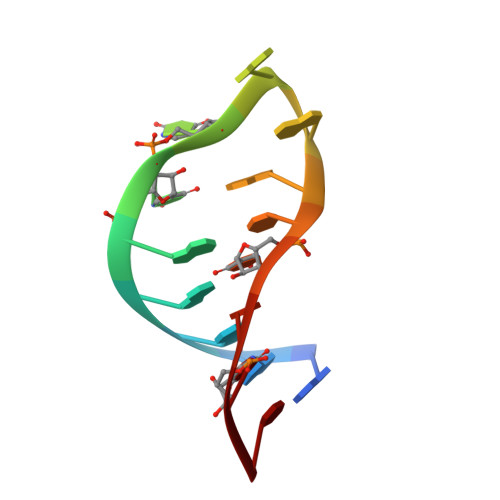Effect of pseudouridylation on the structure and activity of the catalytically essential P6.1 hairpin in human telomerase RNA.
Kim, N.K., Theimer, C.A., Mitchell, J.R., Collins, K., Feigon, J.(2010) Nucleic Acids Res 38: 6746-6756
- PubMed: 20554853
- DOI: https://doi.org/10.1093/nar/gkq525
- Primary Citation of Related Structures:
2KYE - PubMed Abstract:
Telomerase extends the 3'-ends of linear chromosomes by adding conserved telomeric DNA repeats and is essential for cell proliferation and genomic stability. Telomerases from all organisms contain a telomerase reverse transcriptase and a telomerase RNA (TER), which together provide the minimal functional elements for catalytic activity in vitro. The RNA component of many functional ribonucleoproteins contains modified nucleotides, including conserved pseudouridines (Ψs) that can have subtle effects on structure and activity. We have identified potential Ψ modification sites in human TER. Two of the predicted Ψs are located in the loop of the essential P6.1 hairpin from the CR4-CR5 domain that is critical for telomerase catalytic activity. We investigated the effect of P6.1 pseudouridylation on its solution NMR structure, thermodynamic stability of folding and telomerase activation in vitro. The pseudouridylated P6.1 has a significantly different loop structure and increase in stability compared to the unmodified P6.1. The extent of loop nucleotide interaction with adjacent residues more closely parallels the extent of loop nucleotide evolutionary sequence conservation in the Ψ-modified P6.1 structure. Pseudouridine-modification of P6.1 slightly attenuates telomerase activity but slightly increases processivity in vitro. Our results suggest that Ψs could have a subtle influence on human telomerase activity via impact on TER-TERT or TER-TER interactions.
Organizational Affiliation:
Department of Chemistry and Biochemistry, University of California, Los Angeles, CA 90095, USA.














